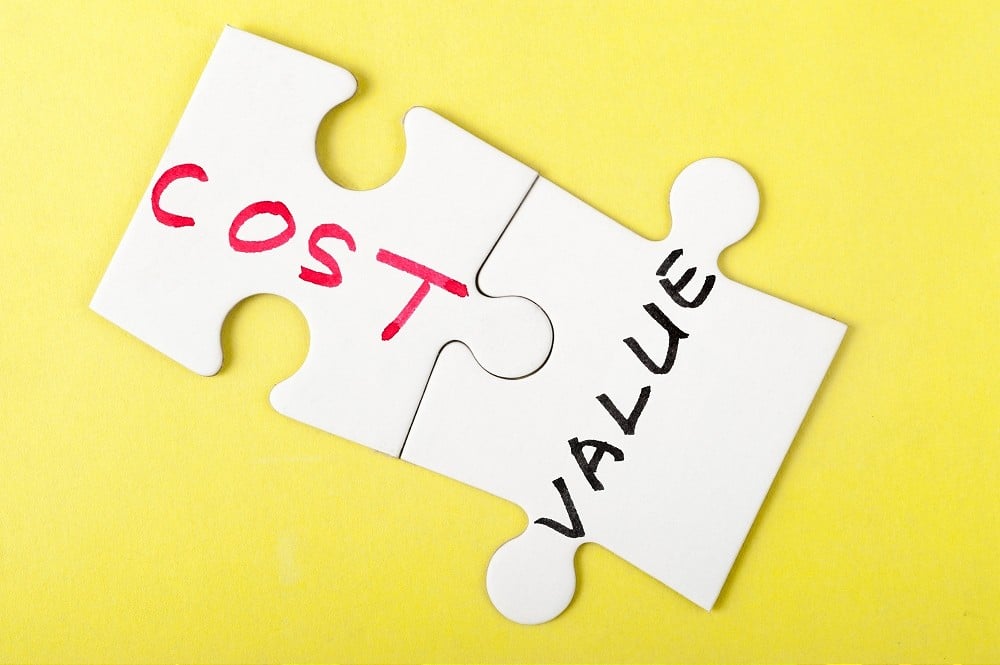
Price Ceiling: What Sets The Ceiling For Product Prices? 🍒
What sets the ceiling for product prices?
>Download Now: Free PDF How to Improve Product Pricing
For every product, a business has to be very careful where it sets its invoice prices. Setting a price below a product’s variable cost, for example, means that a selling organisation is going to lose money on every item that it sells. Setting a price too high (i.e., above the threshold where customers are not willing to pay), on the other hand, means that a selling organisation is going to lose volume and hard earning margin on every sale it makes and even gets a reputation for price gouging. Both situations are bad for business.
To prevent either of these bad pricing situations from happening, good pricing organisations – i.e., ones with a dedicated pricing team – spend a great deal of time, expertise and effort working out the range within which invoice price should be set. Which begs the question: How do pricing teams go about setting the ceiling for their products (i.e., the upper most point in a price range) and what sets the ceiling for product prices?
In this article, we will continue to discuss how pricing teams establish the bounds of new invoice prices; and answer in full a frequently asked question: “What sets the ceiling for product prices?” To do this, we will evaluate three pricing strategies used by pricing teams. Next, we will discuss the disadvantages of setting price ceilings in certain industries. By the end of this article, you will gain knowledge on what sets the ceiling for product prices. You’ll also learn how to narrow down your price ranges and prevent the risk of overcharging or undercharging your customers.
What is A Price Ceiling?
A price ceiling (also called price cap) is the highest price a business can charge for a product or service. For example, by establishing a maximum price for product/service, a business can forecast demand and maintain volumes. In essence, they know with a greater degree of certainty what their customers are willing to pay. As a result, they are not overcharging customers or losing volume. A price ceiling, therefore, helps businesses to establish a more rigorous foundation for price-setting and stabilise demand, supply and production costs.
When and how to apply price ceilings to product prices?
Price ceilings are typically used by companies that manufacture and sell basic necessities or commodity products. Such as food, water, or electricity to protect consumers. However, pricing teams in B2B industrial businesses, manufacturing and distribution also use price ceilings to help them estimate the value of their products in the market. For example, many businesses collect and analyse competitive reference prices to estimate the gap between their price floors and ceiling. More mature pricing organisations, however (i.e., one with a dedicated pricing team), go one step further. And seem to gain a detailed understanding of customer value drivers and translate that understanding into quantified estimates used to support pricing decisions.
Examples of value driver algorithms for manufacturers and B2B distributors seeking to understand the price ranges for their products include:
- Cost drivers – e.g., reduction in mounting costs, procurement costs, handling costs, freight, distribution, cost or service, labour savings.
- Revenue drivers – e.g., new contracts, trading terms and conditions, increased efficiencies and throughput, yield opportunity costs.
- Psychological value drivers – such as convenience, satisfaction, risk and security of supply are subjective in nature; they generally differ by organisation and even by stakeholder. Typically, these psychological estimations are determined by qualitative market research to estimate the worth of a product’s differentiated features. However, many pricing teams also use conjoint analysis too. A technique invented in the 1970s to identify and categorise a product into groups of features. Then provide customers with a series of choices among various feature sets. That is, to understand which they prefer and how much they would be willing to pay (i.e., max price).
Sometimes, price ceilings are temporarily used in unexpected situations too. For example, in crisis situations such as famines, epidemics, during times of war, or after natural catastrophes. Again, this is to monitor and control inventory and assist with demand planning and production.
For instance, during the outbreak of COVID-19 pandemic, some countries set price ceilings for essential goods such as masks and hand sanitiser because of limited supply. Both of these products were found to exceed their price ceiling as opportunistic suppliers sought to raise prices to benefit from the rush in demand for these products.

Three Major Pricing Strategies to Help Find the Right Price In a Given Price Range
In setting the price between the price floor and price ceiling, a business should consider many factors (internal and external). These involve strategies and prices of the competition, the comprehensive marketing mix and strategy, including the nature of the demand and market.
Having said that, there are three major pricing strategies that can help your business find the right price between the two extremes.
-
Value-based Pricing
Typically, good pricing starts with customers and also on how they perceive value. In the end, the customer determines if a product is worth its price or not. Thus, we begin with customer value. When customers purchase a product, they trade something of value (which is the price) in order to get something of value in return. Meaning, getting the benefits of owning or using a particular product. So, it is important to have an understanding of the value that consumers put on the benefits they obtain from the product and establishing a price that exactly captures this value.
In other words, customer value-based pricing uses buyers’ value perceptions instead of the seller’s costs in price setting.
Some companies, like Apple or BMW, pursue a customer value-based pricing strategy. They offer excellent customer value and can get higher prices and margins.
-
Cost-based Pricing
In cost-based pricing, costs are the main consideration. Costs determine the floor for the price that the business can charge. Thus, cost-based pricing sets the price based on the costs of production, distribution and also selling the product. Then, add a fair rate of return to consider efforts and risks in order to make some profit.
For example, Ryanair or Walmart, use a low-cost strategy and seek to provide the lowest prices. This approach comes with accepting smaller profits but higher sales.
-
Competition-based Pricing
Competition-based pricing determines prices based on the costs, prices, strategies, and market offerings of the competitors. In extremely competitive markets, consumers base their judgements of the value of the product/service on the competitors’ prices for similar products/services. For example, the gasoline industry uses competition-based pricing.
What are the Disadvantages of a Price Ceiling?
Shortage of goods or services — An artificial imbalance is created between supply and demand. Shortage happens because the price ceiling does not produce enough profit for companies to generate more supplies that are controlled.
Black market develops or new entrants undercutting — When suppliers of the price-controlled items discover that they can earn more on the black market or by dropping the price or starting a price war. New entrants, for example, often try to penetrate the market by either going below established price floors. Or going substantially below industry established price ceilings. Price wars and intense competitive price action can often create substantial imbalances in an industry. Especially in terms of supply and demand.
Charging of additional fees — Sometimes, you’ll see more additional fees being created by businesses when they have set high price ceilings. For instance, charges such as a handling fee, administrative fee, a service fee, or a fuel surcharge are quite common. The aim is to increase the company’s total margin. At the same time, staying within the legal limits of the law (theoretically).
Poor quality of goods – Businesses lower the quality of their goods in an effort to maintain their profit. For example, a seller of baked products could use low-quality flour in the products sold. In other words, price ceiling tends to set artificial restrictions on the market, which buyers and sellers might work to avoid.
Discussion: What sets the ceiling for product prices and how to set them?
The price ceiling, then, is generally determined by gaining a detailed understanding of customer value drivers; then translating them into quantified estimates. How customers perceive the value of a product (also known as the value to the customer) sets the upper bound of its price. In typical situations, the level of a product’s variable costs forms the lower bound of its price, which can be referred to as its price floor. The products’ price should be set somewhere in between these two bounds.
To establish the price between these two extremes, therefore, a pricing team considers various internal and external inputs. For example, if there turns out to be very little space between the upper and lower bounds of a price, then the product’s price should be set right in the spot. However, when there is a substantial range between these bounds, then simply knowing them leaves open the important question of where within these bounds should the price be initially set. This decision largely depends on price positioning, product strategy and segmentation.
Implications
Businesses will respond to price ceilings invariably by reducing the quality of the products sold, switching to black markets, or charging additional fees to their goods and services.
Price ceilings create artificial shortages. When demand increases, prices also increase to entice a higher level of production. On the other hand, when prices are artificially established below the equilibrium level, prices are low, demand is great, and suppliers are not able to meet supply.
In setting the price between the price floor and price ceiling, a company should consider a lot of factors. Both internal and external. These include strategies and prices of the competitors, the overall marketing mix and strategy. Not only that but also the nature of the demand and market.
〉〉〉 Get Your FREE Pricing Audit 〉〉〉
Conclusion
A price ceiling is an upper point in a price range or the maximum price a product can be sold. The goal of a price ceiling is to keep prices fair for the business and their customers. That is, in a range where prices are profitable but not increasing too quickly.
Businesses and governments alike use price ceiling to avoid destabilising markets and creating supply and demand issues. However, there are always opportunistic competitors out there who are prepared to fight dirty and slash prices below established price floors or raise prices above the price ceiling. These are typically smaller operators, less regulated industries and/or black market operations. Such as groups or businesses keen to take advantage of yield opportunities available in demand curves or supply shortages i.e., via price gouging behaviours and/or illegal and unfair pricing of products/services.
Setting the optimal price ceiling is not an easy process because it always begins with understanding how customers value a product or service. However, many businesses still have not established price ceilings for their products. For the reason that they do not understand their customer base and/or use a cost-plus methodology to set prices.
Cost-plus is not the best way to establish either price floors or price ceilings because it is very difficult to accurately determine costs when costs are fluctuating. On top of this, research consistently shows that a focus on cost caps revenue as teams fail to explore the total economic value of the product portfolio.
To learn more about the latest pricing techniques and strategy, click here to download the whitepaper on pricing strategy.
For a comprehensive view and marketing research on integrating a high-performing capability team in your company,
Download a complimentary whitepaper on How To Maximise Margins.
Are you a business in need of help to align your pricing strategy, people and operations to deliver an immediate impact on profit?
If so, please call (+61) 2 9000 1115.
You can also email us at team@taylorwells.com.au if you have any further questions.
Make your pricing world-class!
Related Posts
Leave a Reply Cancel reply
Categories
- marketing strategy (26)
- Organisational Design (14)
- Podcast (114)
- Pricing Capability (87)
- Pricing Career Advice (10)
- Pricing Recruitment (19)
- Pricing Strategy (289)
- Pricing Team Skills (13)
- Pricing Teams & Culture (24)
- Pricing Transformation (47)
- Revenue Model (25)
- Sales Effectiveness (27)
- Talent Management (7)
- Technical Pricing Skills (35)






